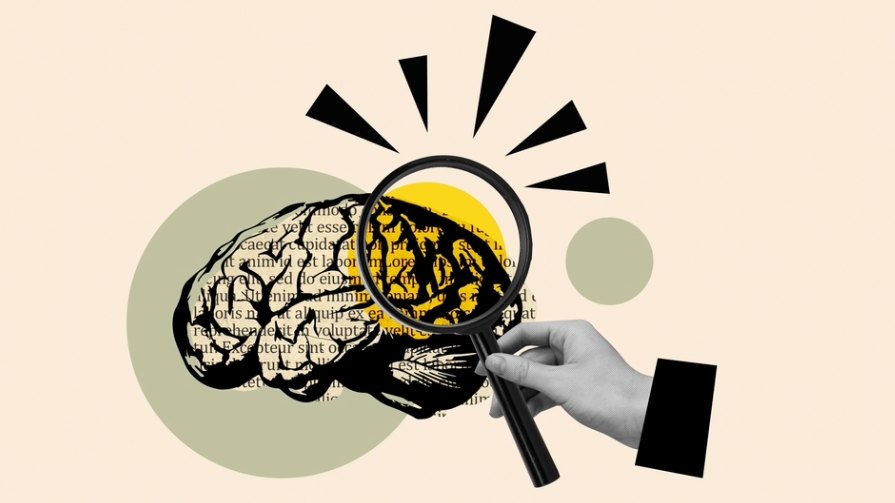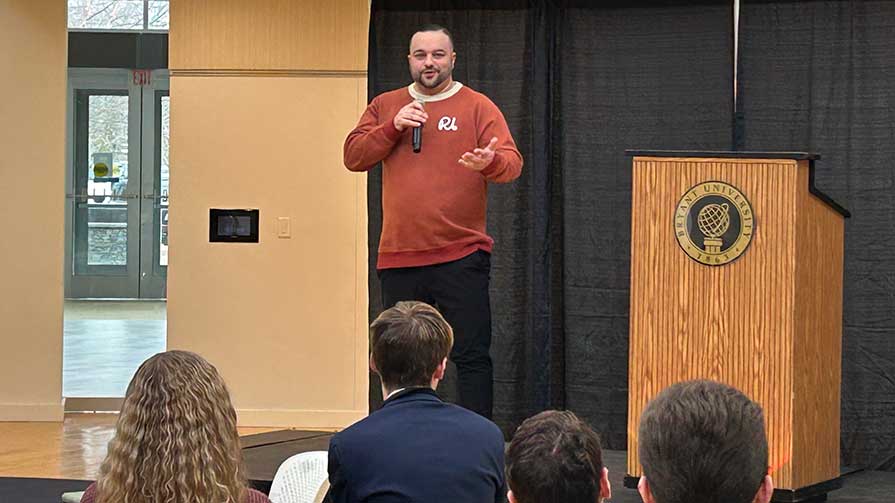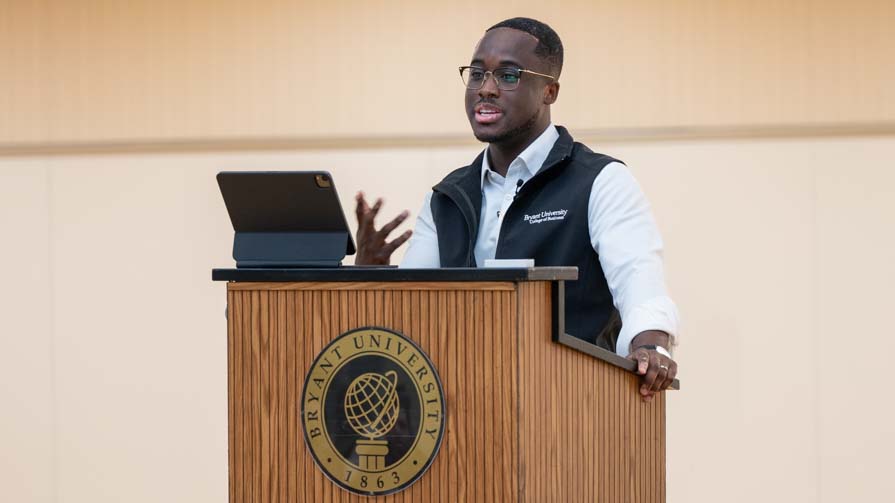SMITHFIELD, RI – From Mon., Jan. 22 to Wed., Jan 24, 2018, the entire freshman class will return to campus a few days before regular classes start to take part in Bryant’s Innovation and Design Experience for All (IDEA) program. This intensive design thinking boot-camp, now in its sixth year, is just one of many ground-breaking initiatives that puts Bryant on the leading edge of a movement to innovate in higher education.
For an action-packed three days, cross-disciplinary faculty along with peer, alumni, and staff mentors will lead students through a process that simulates the fast-moving, wild-idea-generating, innovative way of doing business practiced by many of the largest, most successful companies in the world including IDEO, Apple, Google, Intuit, IBM, BMW, and Proctor & Gamble.
The mission
IDEA's mission is to open students’ minds to innovative ways of thinking and creating that they will incorporate in every aspect of their four years at Bryant and throughout their lives and careers. They will develop specific skills and habits of mind that will prepare them for the rigors of academic life and a fast-changing world that will soon be in their hands.
"The biggest challenge with teaching design thinking is getting the students comfortable with not knowing the answer, and that they will likely fail before they succeed."
“We are educating and inspiring the innovative leaders for the future,” said Bryant President Ronald K. Machtley. “Through innovations in what we teach and how we teach it, we provide students with the education and the opportunities to learn how to think and apply what they’ve learned in creative ways that create value and generate positive change.”
Evolution of design thinking at Bryant
Design thinking is a creative problem-solving process that has helped world changers like Steve Jobs to develop some of their most valuable products and ideas.
About seven years ago, Bryant faculty and leaders began applying the ground-breaking design thinking process to reimagining higher education. Since then, Bryant has put these concepts into action, not only to develop innovative ways of teaching and learning, but also to foster a university-wide culture of innovation. The IDEA program, launched in 2013, led Bryant administrators and faculty to recognize that a new way of learning would require a new kind of space. This kicked off an integrative and collaborative design process that resulted in the building of the Academic Innovation Center (AIC) that opened in September 2016. President Machtley called the opening of the AIC “a strategic inflection point” that has led to even more program innovation at the undergraduate, graduate, and executive education levels.
What happens at IDEA?
The IDEA program guides students through the design thinking methodology popularized by IDEO, the Palo Alto-based global design firm that has helped companies develop some the most innovative products and systems in the world. The process starts with conducting ethnographic field research, and continues with defining user needs based on insights, ideation (brainstorming) to explore multiple possible solutions, engaging in rapid prototyping, test the solutions with the users, and continually iterating to evolve the idea based on user feedback.
All members of the freshman class gather on day one for an introduction to design thinking. From there, students head off on a high-energy, low-sleep, design-thinking adventure. They learn how to brainstorm, generate wild ideas, and begin to get comfortable with not knowing the answers. Team-building workshops (sponsored by EY and Citizen’s Bank) provide opportunities to practice working collaboratively to find solutions. Students discover that patiently sticking with this catalytic process, which emphasizes learning from failure, will lead to success.
"The design thinking process trains students to discover an answer that didn’t exist before, and that’s innovation.”
“Design thinking can be hard for the brain,” says Allison Butler, 2018 IDEA program director and Associate Professor of Psychology. “Our brains are wired to operate as efficiently as possible, which is ideal for making our way through daily life, but often an impediment to innovation. We teach our students strategies for removing cognitive blocks to free them up to generate wild ideas, experiment with them, and be truly creative.”
Creating a start-up environment to solve businesses problems
With an understanding of basic design thinking principles, students head out to more than 30 regional organizations, including the New England Patriots Hall of Fame, Bass Pro Shops, and the Providence Tourism Council, to apply what they’ve learned to solving real challenges for businesses and in the community.
“We create a start-up atmosphere as we try to replicate Silicon Valley for three days,” says Mike Roberto, IDEA co-founder, Trustee Professor of Management, and director for the Center of Program Innovation. “The biggest challenge with teaching design thinking is getting the students comfortable with not knowing the answer, and that they will likely fail before they succeed. The design thinking process trains students to discover an answer that didn’t exist before, and that’s innovation.”
"It’s really forward-thinking for Bryant to be infusing this into the curriculum."
At their assigned locations, each team of about five students tackles the first step of the process—ethnographic field research—or interviews and observations of the users in their natural environment. Then it’s back to the campus for brainstorming and rapid prototyping. Breakout rooms across the campus are transformed into dynamic ideation labs covered in sticky notes and storyboards to spark creative thinking. Faculty, student, and alumni mentors encourage the students to generate wild ideas. Refrains of "Fail early to succeed sooner!” and “Build to think!” echo throughout campus for the duration of the program. Ultimately, students create a 3-D model of their solution, and pitch it at a Trade Show to guest judges from businesses and community organizations. They are evaluated on their ideas, and even more importantly, the thinking process that led to their recommendations.
Through the process, students develop the traits of innovators: curiosity and creativity; integrative thinking; collaboration; connecting; and perseverance and grit.
The entire community gets involved
Alumni come from all over the country to participate, serving as mentors and judges. Upperclassmen serve as peer mentors, and business executives and community leaders from around the region also volunteer as mentors and judges.
“I’ve taken IBM-sponsored classes on innovative ways of problem solving. It’s really forward-thinking for Bryant to be infusing this into the curriculum,” said Andrew Corrado ’87, Senior Vice President, Group Director, Signature Bank in Melville, NY. Corrado’s son Andrew Jr. ’20 participated in IDEA in 2017.
The impact
IDEA creates a foundation for the way students approach their four years at Bryant, and they gain critical thinking, relationship, and project management skills that give them an advantage and help them to add value in the marketplace.
Nina Luiggi ’18 participated in IDEA as a freshman and took Psychology/Management 440, an interdisciplinary upper-level design thinking class, in her junior year. These experiences enabled her to secure an internship with Caravan Studios, a San Francisco non-profit that builds apps to help communities organize, where she excelled and impressed her employers. “[Nina] demonstrated genuine curiosity in learning, not just collecting data points, and the ability to make connections across those data points,” said Marnie Webb, CEO of Caravan Studios. “She showed strong skills in presenting the material to senior team members.”
Renee Lawlor ’15, a former student mentor, said that the IDEA program was the best part of her Bryant education. Now in the role of Launch Manager at the IDEO spinoff company PillPack, Lawlor recognizes that “every day I have to be nimble as my job changes, plans change, and needs change as we work to make the product, service and experience better for the customer.” She adds, “My Bryant experience prepared me for this.”
Building momentum with education and corporate partners
Innovation at Bryant continues to gather steam as the University integrates design thinking throughout the curriculum, partners with businesses, schools, and organizations, and applies these principles to preparing the organization and its students for future success.
Bryant faculty, the Executive Development Center, and the Hassenfeld Institute for Public Leadership have worked with a number of regional and global organizations including Fidelity Investments, Citizen’s Bank, FM Global, Hasbro, Amica Insurance, CVS Health, the Rhode Island National Guard, and the Lincoln School.





